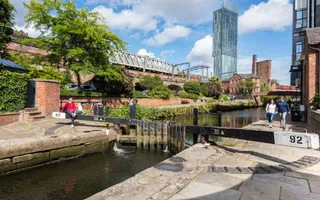Although the great canal engineers of the industrial age could never have envisaged it, our network of canals and river navigations in the hearts of our towns and cities are perfectly placed to provide ‘net zero' solutions and climate change mitigation.

Nine ways canals can fight climate change
We believe our waterways can play an important role in mitigating the impacts of climate change as well as playing a vital part in reducing greenhouse gas emissions, which are driving global warming.
Read the video transcript
Nine ways canals can tackle climate change.
The Canal & River Trust looks after more than 2,000 miles of inland waterways throughout England and Wales, and our unique network is starting to play a vital role in the UK’s fight against climate change.
Active travel and low carbon transport: our towpaths offer appealing, traffic-free, active travel routes to nine million people living within a ten-minute walk of our waterways. And every year, thousands of tonnes of freight are moved along our canals and rivers.
Heating and cooling systems: canal water can be used to heat and cool canalside buildings using water-sourced heat pumps, which are significantly more efficient than their air-sourced equivalents.
Reducing urban temperatures: the urban heat island effect increases temperatures in city centres, and this is said to worsen as temperatures rise. Water has a natural cooling effect, making urban areas next to waterways pleasant spaces to live and work and up to 1.6 degrees cooler.
Transferring water: it’s predicted that droughts will become more frequent, more severe, and more widespread. The Trusts’ waterways can help alleviate shortages by transferring water from areas with a surplus to those with higher levels of water stress.
Addressing flooding: the Trust’s canals are artificial channels that cut across natural drainage paths. With the right investment, they can play a role in mitigating flood risks by intercepting drainage, holding up flows, and even moving water away from towns and properties at risk.
Utilising hydropower: hydropower from our waterways generates 20 million kilowatt hours, which equates to power for around 6,200 homes and saves around 9,500 tonnes of CO2.
Low carbon energy for boats: the Trust is partnering in pilot schemes to install electricity charging points at inner city moorings, which encourages the use of electricity for heating as well as propulsion.
Helping nature recovery: nature-rich canalsides act as vital wildlife corridors, helping to connect isolated natural habitats so wildlife can spread, recover, and thrive again.
Providing ‘doorstep destinations’: having great destinations on their doorstep prevents people from having to travel by car to spend time in nature. Whether it’s a short visit with the kids to see the ducks, an afternoon of paddleboarding, or a trip to a canalside pub, less travel will help reduce CO2 emissions.
The canals that were built to support the first Industrial Revolution can be used to deliver the Green Industrial Revolution. And we do all of this whilst also ensuring that our canals and rivers continue to be a back garden for everyone to enjoy any time. To find out more, please search Canal & River Trust.

Find out more about the ways we mitigate climate change
Discover more
Last Edited: 24 December 2024


Stay connected
Sign up to our newsletter and discover how we protect canals and help nature thrive














